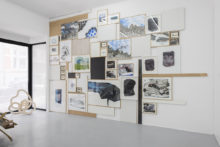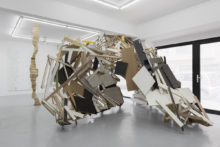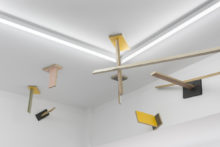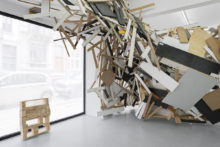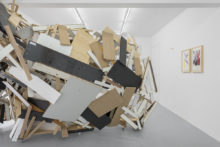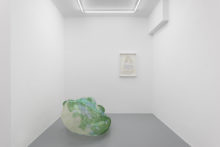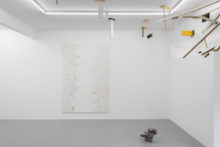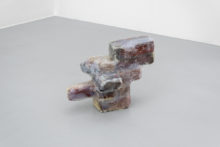Tatiana Wolska
and Guest Pascal Pinaud
Tatiana Wolska, Principle of uncertainty
Tatiana Wolska has taken an important step forward in her work by developing its constructive aspect, without losing the ephemeral nature of previous installations, such as those presented at Palais de Tokyo a few years ago. The fundamental change is in the type of objects she uses, even if they are still waste materials, exploited in a logic of remediation and reusability. The flexible and biomorphic forms of her lightweight structures have given way to stronger and more stable constructions. These constructions, seemingly almost self-generated, literally take over the places they fill up, little by little, settling themselves in and taking support upon their surroundings. Suspended structures have turned into real constructions – whether they take place inside (Nice, Galerie de la Marine) or outside (Brussels, Foundation Boghossian), the process is identical.
Plank after plank, nail after nail, the structure is put in place. It occupies the space and generates in its center its own inner shell, giving it the look of a cave with steep walls, a kind of two-sided building whose internal and external walls, if they have the same raw look, do not have the same function. These sculptural structures, somewhat off-putting from the outside and sometimes creating a certain distance because of their monumentality, become basic alcoves, akin to a cave that could almost be described as prehistoric if you let the imagination run wild. The constructions, if not really habitable – purposefully – can be slowly and carefully crossed by the visitor and are de facto usable and used by the artist. One of them, recenlty shown in Nice, was aptly titled « Habitat potentiel pour une artiste » (Potential Habitat for an Artist). During the time of their edification – about a week – they can be considered not only as an extension of the workshop, but also as a true experience of creation in space, true to scale. In other words, in this development process, there are no small-scale model or intermediate test. Tatiana Wolska
literally works without a safety net, following her intuition, and the structure seems to grow by autonomous propagation.
Tatiana Wolska’s recent exhibitions are, by definition, ephemeral. And so are her installations, such as these large wooden constructions. Despite their monumental and elaborate appearance, they are doomed to disappear at the end of the event. Short-lived works, that nonetheless constitute crucial moments of her practice. The exhibition acquires a central place in her work, as it becomes an artwork in itself and as the creation is conditioned and defined by the exhibition space for which it is intended, in a unique and previously determined temporality. The destruction and disappearance of the work, the dispersion of its constituent elements are included in the very process of its elaboration. It is probably also because Tatiana Wolska does everything she can to avoid being locked in a process or a system, being dependent on a manufacturing process, limited to a single material, or, worse, a form that could be easily associated with
her. The titles of some of her personal exhibitions are also revealing in this regard: « Contre-temps », « Work in Progress » and especially « Principe d’incertitude ».
Tatiana Wolska’s sculptural practice is located on the dividing line between architecture and material recycling, but she never renounced drawing, which she considers to be on the same level as sculpture. But that’s another story…
– Bernard Marcelis
Some news about Tatiana Wolska in Brussels :
Melancholia, Villa Empain
Present, Musée Van Buuren
Pascal Pinaud is a contemporary French artist whose practice revolves around painting. Since the late 1980s and his graduation from la Villa Arson (FR), Pascal Pinaud has reinvented contemporary painting through processes and methods developed in separate series.
Read more about Pascal Pinaud

